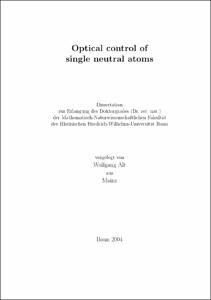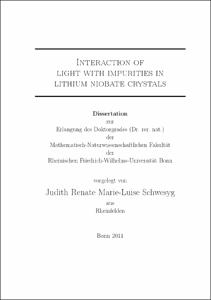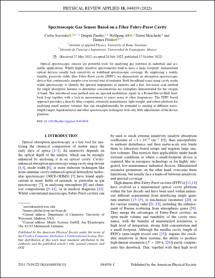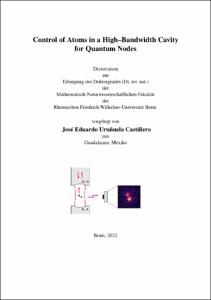Optical control of single neutral atoms

Optical control of single neutral atoms

| dc.contributor.advisor | Meschede, Dieter | |
| dc.contributor.author | Alt, Wolfgang | |
| dc.date.accessioned | 2020-04-06T21:22:40Z | |
| dc.date.available | 2020-04-06T21:22:40Z | |
| dc.date.issued | 2004 | |
| dc.identifier.uri | https://hdl.handle.net/20.500.11811/2090 | |
| dc.description.abstract | This thesis presents experiments concerning the preparation and manipulation of single neutral atoms in optical traps. The experimental setup as well as the properties of the optical dipole trap are described. The examination and control of all trapping parameters and heating effects is a prerequisite for the future realization of quantum gates. A magneto-optical trap captures and cools down a few cesium atoms. By efficiently detecting their fluorescence, we are able to determine their exact number. They are then transferred without loss into a standing-wave optical dipole trap. The temperature of the atoms in this trap is measured using two methods which are devised to work with small numbers of atoms: By adiabatically lowering the trap depth, an energy-selective loss of atoms is obtained, which yields the energy distribution of the atoms in the trap. Alternatively, the temperature is inferred from the size of the cloud and from the oscillation frequencies of the atoms in the dipole trap. The oscillation frequencies are determined using resonant and parametric excitation. Various intrinsic as well as technical heating mechanisms in the dipole trap are examined experimentally and theoretically. Finally, the setup of a miniature ultra-high finesse optical resonator is presented, which will be used to couple two trapped atoms via the exchange of a photon. The optical resonance frequency of the resonator is successfully stabilized to the atomic transition by an electronic servo loop. | en |
| dc.description.abstract | Optische Kontrolle einzelner neutraler Atome Die vorliegende Arbeit berichtet über Experimente zur Präparierung und Manipulation einzelner neutraler Atome in optischen Fallen. Der experimentelle Aufbau wird vorgestellt, und die Eigenschaften der optischen Dipolfalle werden beschrieben. Für eine zukünftige Realisierung von Quantengattern ist die Untersuchung und Kontrolle aller Fallenparameter und Heizmechanismen entscheidende Voraussetzung. Einzelne Cäsiumatome werden von einer magneto-optischen Falle eingefangen und gekühlt. Durch eine effiziente Detektion des Fluoreszenzlichtes können wir die genaue Zahl der gefangenen Atome bestimmen. Anschließend werden die Atome verlustfrei in eine optische Stehwellen-Dipolfalle umgeladen. Ihre Temperatur in dieser Falle wird mit zwei Meßverfahren bestimmt, die speziell dazu entworfen wurden, mit einer sehr geringen Anzahl von Atomen zu funktionieren: Zum einen wird ein energieabhängiger Verlust von Atomen durch ein adiabatisches Absenken der Fallentiefe erreicht und damit die Energieverteilung der Atome in der Falle bestimmt. Zum anderen wird die Temperatur aus der Größe der Atomwolke und den Oszillationsfrequenzen der Atome in der Dipolfalle abgeschätzt. Die Oszillationsfrequenzen werden mittels resonanter und parametrischer Anregung bestimmt. Verschiedene fundamentale sowie technische Heizmechanismen in der Dipolfalle werden experimentell und theoretisch untersucht. Schließlich wird der Aufbau eines miniaturisierten optischen Resonators sehr hoher Finesse präsentiert, der später verwendet werden soll, um eine kontrollierte Wechselwirkung zwischen zwei gespeicherten Atomen durch den Austausch eines Photons zu erzeugen. Die optische Resonanzfrequenz des Resonators wurde mittels einer elektronischen Regelschleife erfolgreich auf den atomaren Übergang stabilisiert. | en |
| dc.language.iso | eng | |
| dc.rights | In Copyright | |
| dc.rights.uri | http://rightsstatements.org/vocab/InC/1.0/ | |
| dc.subject | Laserkühlung | |
| dc.subject | Magnetooptische Atomfalle | |
| dc.subject | Dipolfalle | |
| dc.subject | Quantenoptik | |
| dc.subject | optischer Resonator | |
| dc.subject | Frequenzstabilisierung | |
| dc.subject | optical cooling and trapping of atoms | |
| dc.subject | magneto-optical trap | |
| dc.subject | dipole trap | |
| dc.subject | quantum optics | |
| dc.subject | optical cavity | |
| dc.subject | frequency stabilization | |
| dc.subject.ddc | 530 Physik | |
| dc.title | Optical control of single neutral atoms | |
| dc.type | Dissertation oder Habilitation | |
| dc.publisher.name | Universitäts- und Landesbibliothek Bonn | |
| dc.publisher.location | Bonn | |
| dc.rights.accessRights | openAccess | |
| dc.identifier.urn | https://nbn-resolving.org/urn:nbn:de:hbz:5N-04297 | |
| ulbbn.pubtype | Erstveröffentlichung | |
| ulbbnediss.affiliation.name | Rheinische Friedrich-Wilhelms-Universität Bonn | |
| ulbbnediss.affiliation.location | Bonn | |
| ulbbnediss.thesis.level | Dissertation | |
| ulbbnediss.dissID | 429 | |
| ulbbnediss.date.accepted | 30.09.2004 | |
| ulbbnediss.fakultaet | Mathematisch-Naturwissenschaftliche Fakultät | |
| dc.contributor.coReferee | Klempt, Eberhard |
Files in this item
This item appears in the following Collection(s)
-
E-Dissertationen (4391)







